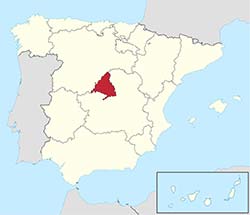Madrid in Madrid

Madrid is a one-province autonomic region, and its capital, Madrid, is also the capital of Spain.
 It is situated in the centre of the Iberian Peninsula and borders on the provinces of Guadalajara, Cuenca and Toledo in Castilla-La Mancha, and Avila and Segovia in Castilla y Leon.
It is situated in the centre of the Iberian Peninsula and borders on the provinces of Guadalajara, Cuenca and Toledo in Castilla-La Mancha, and Avila and Segovia in Castilla y Leon.
It is only Spain’s third region in population size with 6,640,705, superseded by AndalucIa with 8,426,405 and Catalonia with 7,565,099 inhabitants. However, as far as density of population per km2 is concerned, it is far superior to those two: 820.59 compared to 99.95 in Andalucia and 234.07 in Catalonia. The surface area of Madrid is 8,028 krn2, Catalonia 32,113 and Andalucia 87,599.
In spite of its small size and relatively large population, the Region of Madrid still has many well preserved animal habitats and landscapes, with mountain peaks more than 2,000m tall, river flats and plains.
Apart from the capital Madrid, the region of Madrid is also home to many small and medium sized towns, such as Alcalá de Henares, a famous university town whose historic centre has been named a World Heritage Site by Unesco, and which is summer home to a large population of storks. And Buitrago del Lozoya, which is set on a promontory in the River Lozoya and is famous for the preservation of its old walled precinct.
All in all there are 179 municipalities in the region.
Madrid capital lies at the centre of the region and covers 604.3 km2. The city proper is home to approximately 3.3 million souls, and the population of the whole metropolitan area is more than 6.5 million.
As the capital of all of Spain, Madrid is home to the government and its ministries, the prime minister, the congress and senate, the supreme and constitutional courts and the royal family.
Madrid is Europe’s fourth most wealthy city after London, Paris and Moscow.
Some of Madrid’s museums are of world renown, the most famous of them of course is Museo del Prado, which is the world’s 12th most visited museum. Also the Museo Reina Sofia, a museum for contemporary and 20th century art which opened in 1992, and the Museo Nacional Thyssen-Bomemisza, attract hundreds of thousands of visitors every year.
Madrid has always been thought to have been founded in the 9th century by the Moors when they constructed a castle (alcazar) named Majrit (‘source of water’ after the river, RIo Manzanares, traversing the region), but recent finds point to both Roman and Visigoth presence in the area before then.
Although Madrid was conquered by the Christians in the 10th century, it remained a small town where Christians, Jews and Moors lived side by side for the next 500 years.
However, when the Catholic ‘Reconquista’ ended, Madrid took on growing importance, and by 1513 it had 15,000 inhabitants, and in 1561 Felipe II made it the capital of Spain when he established his court there. This greatly boosted both the city’s demographic development and financial prosperity, and Madrid started to grow in earnest. However, it would be quite some time before Madrid could legally call itself the capital of Spain; not until 1931, with the advent of the Second Spanish Republic, was the city constitutionally made capital.
Madrid is Spain’s most visited city with 9,716,708 foreign and Spanish visitors last year compared to Barcelona’s 8,045,642 It is visited by more Spaniards than Barcelona, but comes second when it comes to foreign visitors.
The capital of Spain is known for it great cultural heritance. its gastronomy, the architecture, markets and the list goes on.
The most popular tourist attractions include, apart from the art museums, the Retiro Park, the Royal Palace, the Puerta del So!, the San Miguel Market and the Gran Via.


